Ooo. Lots of adult books with smatterings of children’s literature littered about the pages today. Don’t even know where to start with this one. Let’s see, eeny meeny miney . . . MO!
Libertarians on the Prairie: Laura Ingalls Wilder, Rose Wilder Lane, and the Making of the Little House Books by Christine Woodside
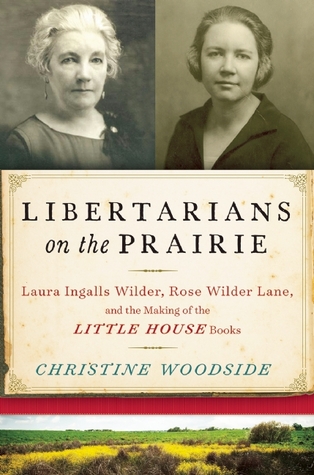
This is the most interesting of the batch in many ways. This year saw the publication of the book The Selected Letters of Laura Ingalls Wilder, published by editor William Anderson. I know these letters well since Jules Danielson and I used them for our book Wild Things: Acts of Mischief in Children’s Literature. Yet little did I know that the story of Rose Wilder was far more interesting than the degree to which she wrote the Little House books herself or whether or not she could swear like a sailor (she could). Listen to this part of the description:
“Rose hated farming and fled the family homestead as an adolescent, eventually becoming a nationally prominent magazine writer, biographer of Herbert Hoover, and successful novelist, who shared the political values of Ayn Rand and became mentor to Roger Lea MacBride, the second Libertarian presidential candidate. Drawing on original manuscripts and letters, Woodside shows how Rose reshaped her mother’s story into a series of heroic tales that rebutted the policies of the New Deal.“
Nope. Didn’t know that one!
Lois Lenski: Storycatcher by Bobbie Malone

Sometimes a book gets published and I sit in my library and think, “Is anyone else in the entire world going to really read and enjoy this besides me?” Then, after a moment, I’ll get a crazed look in my eye, stand up at my desk, and scream, “THEN I SHALL MAKE THEM ENJOY IT!!!!” Little wonder my desk is sequestered at the end of my floor, far from my cowering co-workers. This Lenski bio may have a limited built-in audience but for Newbery die-hards (Strawberry Girl fans, are you with me?) this is a must. Plus I really like the central conceit involving inherent class structures. Says the description: “Lenski turned her extensive study of hardworking families into books that accurately and movingly depicted the lives of the children of sharecroppers, coal miners, and migrant field workers.” Now somebody out there write me a comparative study looking at how Kate DiCamillo has done similar work with working class people in Florida, with a good compare and contrast of the two award winning authors’ work. And . . . go.
Everybody Behaves Badly: The True Story Behind Hemingway’s Masterpiece The Sun Also Rises by Lesley M.M. Blume

Okay. You’ll bite. What’s the children’s literature connection here? Is it the fact that the book’s about Hemingway and we know that his grandson Eddie Hemingway makes picture books? Is there going to be a revelation in the book that Hemingway based The Sun Also Rises on The Velveteen Rabbit (think about it . . . no, wait, don’t)? No, it’s a lot simpler than that. Its author, Lesley M.M. Blume, has made a veritable plethora of children’s books over the years. My personal favorite was her Modern Fairies, Dwarves, Goblins, and Other Nasties: A Practical Guide by Miss Edythe McFate. Now she’s getting stellar reviews on the adult side of things. Bully for her, says I! Well done!
Love From Boy: Roald Dahl’s Letters to His Mother by Donald Sturrock

What We Know: 2016 marks 100 years since the birth of Roald Dahl.
What That Means: Lots o’ books about Dahl. Some covering areas we’ve seen before. Others traipsing into new territory. I certainly haven’t seen this one before and as the mom of a 2-year-old boy it gets frighteningly close to teary-eyed territory. I also love this part of the book’s description: “Sofie Magdalene kept every letter her son wrote to her (sadly, her own side of the correspondence did not survive).” Tsk. Ain’t that like a boy.
The Best “Worst President” by Mark Hannah, ill. Bob Staake
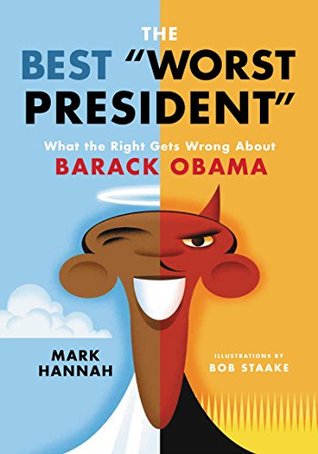
Bob Staake cover and interior art. Nuff said.
Walking with Ramona: Exploring Beverly Cleary’s Portland by Laura O. Foster

One of my catalogers came up to me the other day, book in hand. Baker & Taylor has cataloged this book as 813.54 (literary stuff) but the book is clearly (Cleary-ly?) a travelogue. Indeed, open it up and you get a whole mess of delightful Portland, Oregon haunts. Where the HECK was this book when I was moving there, all those years ago? I would have lapped it up. As it stands, it’s really very delightful. Those of you planning to move there, or have friends or kids moving there, grab this thing. Like I say – Ramona invented the original Portlandia.
In the Great Green Room: The Brilliant, Bold Life of Margaret Wise Brown by Amy Gary
Hold the phone. Now hand the phone to me. Someone else besides Leonard Marcus has written a biography of Margaret Wise Brown? Who is this Amy Gary type personage? Sez the description: “In 1990, author Amy Gary discovered unpublished manuscripts, songs, personal letters, and diaries from Margaret tucked away in a trunk in the attic of Margaret’s sister’s barn. Since then, Gary has pored over these works and with this unique insight in to Margaret’s world she chronicles her rise in the literary world . . . Amy Gary has cataloged, edited, and researched all of Margaret’s writings for the last twenty-five years.”
Oh. There you go then.
Okay. One more.
Looking for Betty MacDonald: The Egg, the Plague, Mrs. Piggle-Wiggle, and I by Paula Becker-Brown

For whatever reason I feel like this is slightly more accessible than the Lois Lenski book. Probably because MacDonald had a career outside of children’s literature occasionally. “Readers embraced her memoir of her years as a young bride operating a chicken ranch on Washington’s Olympic Peninsula, and The Egg and I sold its first million copies in less than a year. The public was drawn to MacDonald’s vivacity, her offbeat humor, and her irreverent take on life. In 1947, the book was made into a movie starring Fred MacMurray and Claudette Colbert, and spawned a series of films featuring MacDonald’s Ma and Pa Kettle characters.” Piggle-Wiggle is what she’ll go down in history for, but it’s nice to see another side of her as well. Could have put a little more work into that book jacket, though. Seriously, University of Washington Press. You weren’t even trying.

What do you say when you are asked to draw one of the great characters of children's literature? YES! And YES, PLEASE!
That's what I answered when the Oregon Children's Theatre approached me to provide a drawing of Ramona to promote their upcoming production of Ramona Quimby. OCT of course had forever endeared themselves to me for their stunning production of The Storm in the Barn two years ago. I leapt at the chance not only to draw Ramona but to work with these great folks again.
As luck would have it, I was reading Ramona the Pest to my daughter when OCT contacted me. But although she was fresh in my mind, capturing Ramona on paper took some work. Here is a sample of the many, many, many sketches I made of Ramona...
Everyone liked those last two, but ultimately we decided the poster needed a bit more of the rambunctious side of Ramona.
One more try, and we settled on the final image.
If you are in Ramona's home town of Portland next May, be sure to catch the show!
There was one of those flurries in the Children’s Book world recently – this time, over the award of the Carnegie, the UK’s most prestigious children’s book award, to the hard-hitting The Bunker Diary by Kevin Brooks. I’m not planning to write much about the controversy (I’ve included some links below) which I’d sum up by saying that some people feel that the Carnegie is forgetting its roots as a children’s book prize by so frequently rewarding the bleaker, and older, end of Young Adult fiction. But the debates that followed did make me think about what exactly we mean when we talk about realism in children’s books.
Because the number one point made by Brooks’ supporters, as it usually is when people complain about bleak children’s books, was the “real life is tough” argument.
“[Children] want to be immersed in all aspects of life, not just the easy stuff. They’re not babies, they don’t need to be told not to worry, that everything will be all right in the end, because they’re perfectly aware that in real life things aren’t always all right in the end.” Kevin Brooks
“the real world is so complex that unambiguously happy endings hardly exist” – author Robert Muchamore
“Children and teenagers live in the real world; a world where militia can kidnap an entire school full of girls, and where bullying has reached endemic proportions on social media” Carnegie Chair of Judges, Helen Thompson
We certainly do live in a grim world. Reading the newspaper can be more heart-breaking than any children’s book. But I’d question whether this explains the preponderance of bleak fiction (and am I being cynical to feel, that if teenagers were truly deeply interested in the worlds’ troubles, there might be more translated foreign fiction available for UK children, instead of, as is actually the case, virtually none?)
For most British children, for all the challenges they face, being imprisoned by a psychopath probably isn’t one of them. (Amazingly the 2014 short list featured two books on the “imprisoned by psychopath” theme – the other by Anne Fine.) Terrorist attack, extreme violence, heroin addiction...these are also very small (though terrifying) risks to most under eighteens, living in a Western world where (though it’s sometimes hard to remember) violence is actually in long-term decline.
Or take childhood cancer. John Green’s The Fault In My Stars is just one the latest of many books where children or teenagers die of terminal cancer. By contrast, I CAN’T THINK OF A SINGLE BOOK WHERE THE CHILD HAS CANCER AND GETS BETTER. And yet, the reality is that about 75% of children do get better. Wouldn't it be great – not least for those children with the disease – if some of the award-winning fiction out there also reflected that reality?
In short, you don’t need to think that children’s books should be all fluffy bunny rabbits and happy ever after to wonder if some so-called “realistic” children’s fiction is...well, actually not that realistic.
Myself, I’ve always thought of “realism” not in association with YA grit but with certain twentieth century American authors: from Laura Ingalls Wilder’s Little House books, through Louise Fitzhugh’s Harriet the Spy, to Judy Blume’s Tales of a Fourth Grade Nothing or Katherine Patterson’s Gilly Hopkins the Great.

Perhaps the supreme example would be Beverley Cleary’s Ramona books. Following the adventures of Ramona Quimby and her family and friends over a number of years, and set in Portland Oregon, these books are breathtaking in their ability to distil the ordinary and humdrum into entertaining fiction.
Beverley Cleary never relies on dramatic events. (She even avoids dramatic titles, with such understated gems as “Ramona and her Mother” and “Ramona Quimby , age 8”.) There are problems for sure – Ramona’s dad loses his job, for example – but as we see things always through Ramona’s eyes, this is on a par with such problems as her class teacher not liking her very much. There is humour (the teacher told me to sit there “for the present” – but I didn’t get any present, Ramona complains). But it’s a gentle, observational humour. There is death (Picky Picky the cat) but no truck with sentimentality (Ramona and Beezus set to work to bury Picky Picky before their parents find out). There are fears to be overcome – confronting a mean dog – and temptations – how can Ramona resist pulling the blonde curls of Susan who sits in front of her in class, however many times she is told off by her teacher? But it is all grounded in a child’s everyday experience.
Beverley Cleary recalled in her memoir,“I longed for funny stories about the sort of children who lived in my neighbourhood.” And she could see that the children she met while working as a librarian felt the same.
Then, as now, this kind of “realism” was often ignored by critics and award-givers. Cleary has been showered with honours and prizes – but that was after her books had proved themselves enduringly popular with young readers. And they still are. I know British children today who ADORE them – because that small town, domestic American life, however distant it is in time and place, still feels absolutely real.
It’s easy to overlook the skill and imagination involved in creating something small scale. As the great mistress of domestic realism, Jane Austen, long ago said of her work, it is “ the little bit (two Inches wide) of Ivory on which I work with so fine a Brush, as produces little effect after much labour". It look easy – but
it isn’t.
Take out the big emotional tear-jerking scenes, the drama of life and death, good vs evil, and what do you have left? The common-place. The everyday. The mundane. And creating something entertaining and captivating out of the mundane is challenging – maybe more challenging than “the big stuff”.
Yet it’s always been an important aim of fiction. Cleary said that she always remembered her college lecturer's advice that a novel should seek to explore universal themes through the minutiae of everyday life. I also like this quote from another writer, Susan Patron, about Cleary. “She showed me that the inner life of any child, the dynamics of family and pets, can be captured as rich, comic, fascinating, poignant, and meaningful."


I’m not sure this type of “realism” has ever been as celebrated in British children’s books, although it is an important part of the appeal of writers such as Jacqueline Wilson and Anne Fine (although their prize-winning books are more “issues” led) or Hilary McKay. With the humour ratcheted up, it’s also the bedrock of Sue Townsend’s Adrian Mole or Louise Rennison’s Georgia Nicolson (I confess the near-death of Georgia’s cat Angus moved me more than any gritty YA novel) and much other comic fiction. It’s even been recognised by the Carnegie in the past, in such books as the groundbreaking The Family From One End Street (one of the first children’s books to feature the everyday life of a working-class family) and The Turbulent Term of Tyke Tyler.
There are lots of joys to be had from fiction, and realism is only one of them. I love fantasy and adventure as much as I love the fiction of the everyday. But I’ve also found that it is often the grounded, “real life” books that are the ones that, as child and adult, I have returned to again and again. There is a particular and lasting joy in reading something “real” and recognising the settings and characters.
Let's celebrate it!
CJ Busby's ABBA post on Carnegie criteria
Bunker Diaries storm in Guardian
Bunker Diaries storm in Telegraph
Bunker Diaries storm: Amanda Craig vs Robert Muchamore
---------------------------------------------------------------------------------

 Emma's new series for 8+ Wild Thing about the naughtiest little sister ever (and her bottom-biting ways) is out now from Scholastic.
Emma's new series for 8+ Wild Thing about the naughtiest little sister ever (and her bottom-biting ways) is out now from Scholastic.
"Hilarious and heart-warming" The Scotsman
Wolfie is published by Strident. Sometimes a Girl’s Best Friend is…a Wolf.
"A real cracker of a book" Armadillo
"Funny, clever and satisfying...thoroughly recommended" Books for Keeps
Emma's Website
Emma’s Facebook Fanpage
Emma on Twitter - @EmmaBarnesWrite
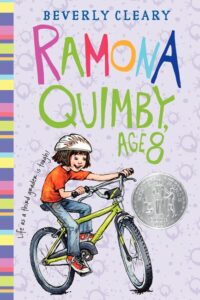 Before we begin I would like to have a few words with the publishers on behalf of catalogers nationwide.
Before we begin I would like to have a few words with the publishers on behalf of catalogers nationwide.
Ahem.
Hi, guys. How’s it going? Heckuva weird weather we’ve had lately, right? Yeah . . . so . . . here’s the thing. You know how you’ve been rereleasing a couple classic children’s books recently like Slake’s Limbo and all the Ramona Quimby books? That is just awesome of you. Seriously, new covers were desperately needed. But, you’re kind of doing this weird thing that’s messing everything up. See, for some reason you’re changing the covers but you’re keeping the old ISBNs. And we wouldn’t really mind if it was just the jackets you were changing, but in the case of the Ramona books you have new interior illustrations. This is a HUGE disservice, not only to libraries, but to your new illustrator, Ms. Jacqueline Rogers. If you keep the same ISBN then in records across the country previous illustrators will be listed in the system. Not Ms. Rogers. So, I know we’re supposedly going to go through some crazy crisis where we run out of all the ISBNs, but do a gal a favor and change the ISBNs on rereleases if you have new interior art (or, also in the case of Ramona, new pagination). It just makes good clean sense.
Okay! Moving on.
- If I say that Travis Jonker fellow at 100 Scope Notes is a nice guy I’m not exactly telling you anything you don’t already know. But how nice is he? Well, in his awesome 10 to Note: Spring Preview 2013 do you know what book he led with? MINE!! I’m thrilled and flabbergasted all at once. Ye gods! I hit the big time, folks! Now I just need to get my hands on that cool looking Lauren Myracle early chapter book and that new Charise Mericle Harper graphic novel. Woot!
- You know you’re cool when the National Coalition Against Censorship collects cool birthday wishes for you. You’re even cooler if those birthday wishes come from folks like Jon Scieszka, Lois Lowry, and the aforementioned Lauren Myracle. And if you happen to be Judy Blume? Icing on the cake, baby.
- On the one hand, it’s awfully interesting to hear folks speculating on what really made Mary Ingalls blind. On the other hand . . . . NBC News linked to me, linked to me, linked to me me me!
- In case you happened to missed it, I hosted a helluva Literary Salon the other day. Yup. Jeanne Birdsall, Adam Gidwitz, N.D. Wilson, and Rebecca Stead all gave up their precious time to stop by old NYPL for a Children’s Literary Salon where they debated why pop culture at large tries to label middle grade fiction as YA. The whole conversation was, for the very first time, recorded for posterity. That’s the good news. The bad news is that the audio feed is lousy. Not sure what I did but it’s a bit mucked up. Clear enough that you could make a transcript from it (casts meaningful looks into the nethersphere) but not so clear that you could actually enjoy listening to it. A little later in the podcast some folks stop speaking into mics. That actually helps. Rear in Gear reports on how it went from the frontlines. By the way, the title “Why YA” is a good one. I might shorten it to Y.YA, then proclaim that to be the newest bestest trend without explanation. Cause that’s how I roll.
- Speaking of my Children’s Literary Salons, I’ve one in early March on the topic of Diversity and the State of the Children’s Book that will prove to be most fascinating (and better recorded, I hope). Much along the same lines is a truly fascinating post over at Ms. Yingling Reads. The post concerns those book jackets that do not reflect the ethnicity of the characters within, but brings up a very interesting p.o.v. from that of the smaller publisher reliant on stock images. This post is your required reading of the day. Many many thanks to Carl in Charlotte for the heads up.
- The post on 10 Fictional Libraries I’d Love to Visit is a lot of fun, but I would add the library featured in Neil Gaiman’s Sandman books most certainly. That would be the library that contains every book conceived of but never published by the world’s greatest writers. The in-jokes alone are worth it. Who doesn’t love Psmith and Jeeves?

Thanks to AL Direct for the link.
- Nerd that I am, I cannot help but be thrilled that the Bologna Book Fair has just established a new prize for the Best Children’s Publisher of the Year. What a fantastic idea, and why has no one else come up with it before? Now THAT is something I can get behind. Boy, yeah.
- Flavorwire’s Conspiracy Theories About Classic Literary Characters doesn’t tell you a lot you haven’t already heard about your classic books (Nick Carraway = gay, Holden Caulfield = gay, yadda yadda yadda) but there are some fun exceptions on the children’s literature side. I think I’ve heard the Winnie-the-Pooh theory before, and I certainly heard the Harry Potter one (Rowling herself even addressed it) but the Wizard of Oz one is actually entirely a new one on me. Huh! Thanks to Annie Cardi for the link.
- I like it when authors reveal the covers of their upcoming books. I especially like it when those authors are folks I’ve heard of before and have enjoyed thoroughly. I met Matthew Kirby (The Clockwork Three, Icefall) at a SCBWI event recently and now I find out that he has revealed his latest title The Lost Kingdom. Yep. I’ll be reading that one.
- The other day I spoke on a panel for some young publishers about the library’s role in the pursuit of Common Core. I was on that panel with Scottie Bowditch of Penguin and John Mason of Scholastic. After the fact I learned that Scholastic has been working to get their hands on all this Common Core schtuf by creating the site Common Sense for the Common Core. It was created to help parents through this tricky time, but no doubt we librarians would benefit a tad as well. FYI!
- You may have heard that tornadoes recently ripped through Mississippi on Sunday causing untold devastation in their wake. They hit in a number of places, including Hattiesburg, Mississippi. Why do I mention this? Well, are you aware what resides in Hattiesburg? That would be the University of Southern Mississippi. And what is the University of Southern Mississippi home to? If you answered that it was the de Grummond Collection “one of North America’s leading research centers in the field of children’s literature” you would also be correct. So did the collection survive the storms? We are happy to report that they did. And on the de Grummond’s Twitter feed they assured everyone that they were safe and sound. Whew!
- Look me in the eye. Right here! Right in my beady little eye and tell me that this is not the smartest use of The Pigeon you’ve seen in a long long time. The crazy thing? I thought they melded together a bunch of different Pigeon books. Not true! Instead, all these panels come from The Pigeon Wants a Puppy.
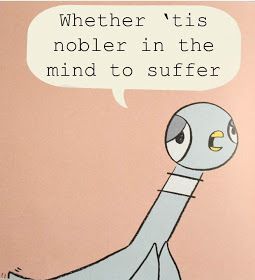
- Remember when NPR started that program they called NPR’s Backseat Book Club? They said they would pick a new book for kids every month and discuss them. Well, the whole “every month” part of that plan has been spotty and the selections have been even spottier. Seems to me NPR isn’t taking full advantage of the field. I mean, Black Beauty and Wimpy Kid? Is that the best you can do? Fortunately it looks like they’ll crank things up a notch when they discuss Gary Schmidt’s Okay for Now. In fact, kids are encouraged to submit some questions to the author ahead of time. Got yourself some kids? Then go to it!
- Speaking of kids submitting stuff, you may have heard that YA author Ned Vizzini is getting into the middle grade fiction arena. He isn’t doing it alone, though. Director Chris Columbus is penning House of Secrets with him. Aside from the fact that the book has an honest-to-god blurb from J.K. Rowling on it (no blurb whore she) kids can get a copy by tweeting Ned their “secrets”. You can see some examples here. Love the kid who used to eat chocolate dog biscuits. That one I believe.
- Would you like $1000? Sure. We all would. But to be a bit more specific, would you like $1000 for your program that uses, “children’s literature as a way to promote international understanding”? Well then are you in luck! USBBY would sure like to give you some cash. Say they, “Schools, libraries, scout troops, clubs and bookstores are all eligible for this award. Does your school or library program or do you know of another organization that “promotes reading as a way to expand a child’s world”? To learn more about the award, view information about past winners and award criteria and access the downloadable application form, please link to: http://www.usbby.org/list_b2u.html“
- Done and done.I wasn’t particularly aggrieved by the Anne of Green Gables brou-de-haha going on about that random cover someone created. In fact, a commenter at ShelfTalker with my name (not me, alas) basically summarized my thoughts on the matter brilliantly when she said, “Folks, you are getting all upset because you MISUNDERSTAND the situation. This is NOT a ‘PUBLISHER’ with a marketing dept. This is a public domain book that some RANDOM PERSON is selling. You could do the same thing. PUBLIC DOMAIN – it means anyone can do anything with it. Here is a list of public domain books: http://www.feedbooks.com/publicdomain. If you want, you yourself could publish, say, Les Miserables by Victor Hugo with a photo on the cover of Governor Chris Christie eating a donut. (If you had the rights to the donut picture of course.)” Which was all well and good . . . but I truly have to tip my hat to Donytop5 who simply replied, “Here Betsy, I found it! http://wolverinesss.tumblr.com/image/42556986881“ That made my day, right there.
- Apparently there’s a competitor to Goodreads out there and it’s calling itself Bookish. It’s not really the same thing as Goodreads, mind you, since it’s publisher driven through and through. Says Media Decoder, “Instead of relying essentially on the taste of other customers with similar preferences, as most recommendation engines do, Bookish’s tool takes into account critical reviews and awards.” Curious, I decided to see what they had in the realm of children’s literature. It’s interesting. Not a ton of content yet, but their recommendations aren’t shabby. Worth eyeing warily for a while.
Someday I will be very rich and I will create a children’s library of my very own. When I do, I will allow one or two walls to be like this:
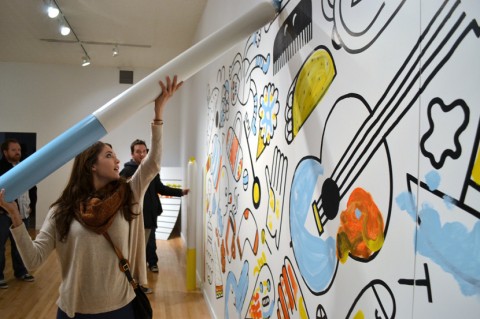
Fortunately if that looks cool to you, you don’t have to wait. Just head on over to the Indianapolis Museum of Contemporary Art and have your fun. Thanks to Swiss Miss for the link!






Our popular feature is back! Blank-Meets-Blank was actually started first by Betsy Bird at Fuse #8 – she ranks the best “Blank-Meets-Blank” when she attends publishers’ librarian previews. This is an awesome way to booktalk to kids and teens in your library or classroom!
Today, we’re sharing the best Blank-Meets-Blanks for our upcoming Fall 2011 titles:

“Richard Scarry meets Where’s Waldo?”
EVERYTHING GOES: ON LAND by Brian Biggs
On-sale 9.13.11

“Kate DiCamillo meets Neil Gaiman”
LIESL & PO by Lauren Oliver
On-sale 10.4.11

“Ramona meets The Penderwicks”
MO WREN, LOST AND FOUND by Tricia Springstubb
On-sale 8.23.11

“Lord of the Flies meets Michael Grant’s GONE”
VARIANT by Robison Wells
On-sale 10.4.11
Well here's a book-to-film adaptation that will definitely go down well at our house. Walden Media has announced that they will be adapting Beverley Cleary's Beezus and Ramona for release in March 2010. Of course, Ramona had her own TV series where Beezus was mainly incidental to the hi-jinks of her younger sister. But in the original book the sister-sister dynamic is much more prevalent, and






























One more Hemingway kid lit connection: He appears in “Turtle In Paradise” as a character. Speaking Of Jenni Holm masterpieces, I finally got around to reading “Penny From Heaven” and was totally blown away. I went to Amazon, curious about reader reviews, and the featured review was a LONG one from 2006 by some librarian named E R Bird “Hall Of Fame top 1000 reviewer.” Now there’s something to put on your resume! (I think whoever this E R Bird character is loved the book as much as I did)
Great list of authors! Since I live in Seattle I especially like Betty MacDonald – she lived in Seattle just a few blocks from my house. And it’s fun to go to the Kitsap Peninsula and try to find the actual farm where ‘The Egg and I’ took place. I think I found where it was once – but it’s not marked with any sign.
Hemingway also appears in Holm’s “Full of Beans,” which on the strength of I totally need to read this book for the other back story.
The sad thing is that ER Bird used to be a “Hall of Fame Top 100 reviewer” before she got lazy. Lazy/kids. Ah, for the days of my prolific youth . . .
“Cleary-ly” made me snort! Thanks. Your sense of humor makes me feel slightly less alienated from humanity.
If my bad jokes can get you through the day, that makes it all worth it, my friend.